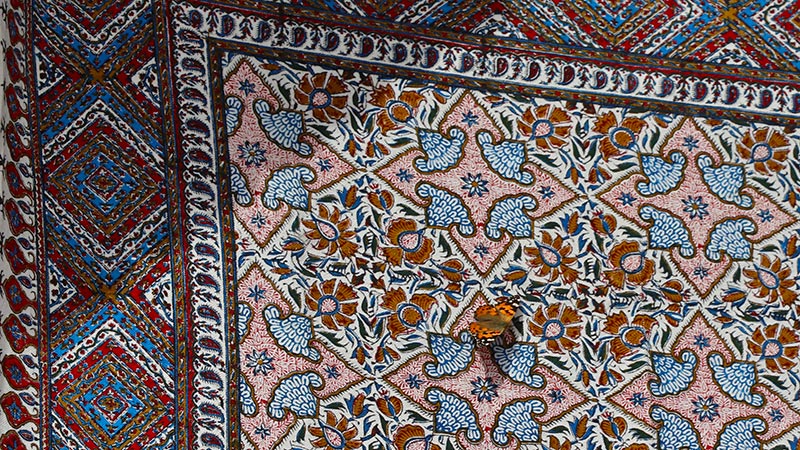 Signin with Google
Signin with Google Signin with Facebook
Signin with Facebook Culture
CulturePersian Ghalamkar, Printed Gardens on Cloth

Persian Ghalamkar, the art of hand printing textiles
It may not be shiny as satin or silk, but your eyes will shine when you see it. Just like a unique work of art, the delicate but straightforward repetitive patterns make your eyes and soul dance along with this elegant cloth. Ghalamkar in Persian translates to Ghalam meaning pen, and Kar means craftsmanship, is an ancient Persian printed cotton cloth that has enchanted so many people for over 400 years.

Ghalamkar, the Glamorous Persian Legacy
Chinese brought their beautifully patterned clothes through the Silk Road and bewitched Iranians with these colourful presents. Inspired by these beautiful textiles, Iranians renovated an indigenous version of patterned fabric, Ghalmkar or Qalamkar. Ghalamkar (calico) is well-known with the name Kalamkar in India that involved in twenty-three steps used in handcrafted wall hanging and textile industry.
Persian artists used pen and ink to draw precise and stunning designs on textiles since the Sassanid era (224-651 CE). Ghalamkar, this rare piece of work soon pleased the taste of the Persian noble class in the 18th century. It became the favoured dress cloth of Safavid emperors for its exquisiteness and beauty. To persuade the excellent demand for Ghalamkar both in and out of the country, artists used patterned wooden blocks to stamp on the clothes.
So many workshops around Iran were active during the 18th century. Shiraz, Yazd, Broojerd, Kashan along Esfahan were the main production centres of this unique printed fabric. Presently, Esfahan and specifically Khorzough create most of the Ghalamkar products throughout the world.

Printing the Tapestry Step by Step
Iranian textile printing process or Ghalamkari starts with washing the starched fabrics to make them soft. After getting dried, the fabrics are ready to get printed. Cotton, silk, calico, flax and linen are used for Ghalamkari as they quickly absorb inks.
Design and dyeing
The artists put the fabric on a short table and use patterned stamps and ink to design the cloth. The wooden stamps are mainly made of hard and flexible wood such as pear or hawthorn wood. The patches have several different patterns and motifs, from flora and fauna designs to arabesque or geometric patterns. Some show a hunting scene, some depicts lovers hand in hand, and some are verses of Persian poems.
Blue, red, black, green, and yellow are the main colours of Ghalamkar handicrafts. Traditionally, dried pomegranate peel, saffron, turmeric, black plum, dried herbs, and indigo were used to dye the fabrics naturally. But today chemical colours and inks are used in Ghalamkari.
The artists delude colours with water then add sesame oil and tragacanth extract to have clean and stable designs. For a four-coloured pattern, there should be four different stamps, one for each colour to overlay colours carefully on top of one another without dispersion.

Fixing the design
Printing is a time consuming and laborious step. Stamping times depend on the size and intricacy of drawings on a tapestry. Preparation of a 2*1.5-meter Ghalamkar tablecloth needs 500 to 4000 times of stamping and several hours of hard manual work.
To fix the designs, the printed clothes get steamed for two or three hours. Then washed in running water and then boiled in a mixture of water and pomegranate peel powder in big copper pots. The pomegranate peel also gives an appealing light buff hue to the tapestries.
A river that flows to make ghalamkar
After getting dried under sunlight, it is time to tide threads together and decorate the ends with tiny tassels. In the past years, when you passed along the Zayandeh River, the river passing through Esfahan city, you could see numerous colourful Ghalamkar pieces carpeting the river bank. That fantastic scene was created because all the washing and drying steps were done in the Zayandeh River.

Qeysarieh Bazaar in Esfahan is the best place to find your favoured Ghalamkar piece. The quality of the fabric and colours, the uniqueness and intricacy of patterns, and the harmony of colours distinguish the exquisite Ghalamkar handicrafts. After centuries, Ghalamkar still is at the pinnacle of fame in the world. Although traditional table cloths and mats are more popular, nowadays Ghalamkar clothes become stylish modern dresses, scarves and purses to persuade a broader range of demands.
By Samaneh Zohrabi / TasteIran



